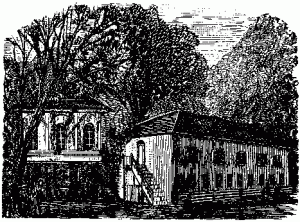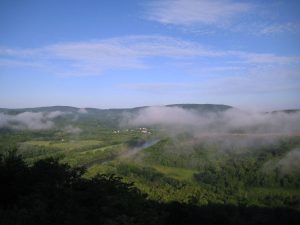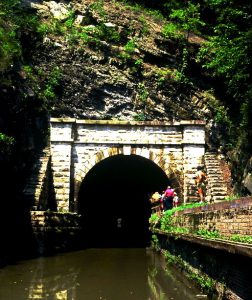
 The three counties of the Eastern Panhandle of West Virginia — Morgan, Berkeley and Jefferson — make up the Washington Heritage Trail. Experience a rich timeline of American history that includes a colonial spa town, sites of early industries, railroad landmarks and Civil War locations. The footsteps of America’s first president are particularly prominent, along this 127-mile driving trail named for George Washington and approved as a National Scenic Byway and West Virginia Scenic Byway.
The three counties of the Eastern Panhandle of West Virginia — Morgan, Berkeley and Jefferson — make up the Washington Heritage Trail. Experience a rich timeline of American history that includes a colonial spa town, sites of early industries, railroad landmarks and Civil War locations. The footsteps of America’s first president are particularly prominent, along this 127-mile driving trail named for George Washington and approved as a National Scenic Byway and West Virginia Scenic Byway.
Although George Washington’s footsteps are the primary focus of the trail, sites in the three counties make the trip one of discovery for travelers interested in everything from architecture to scenic wonders.
From his first visit as a teenage surveyor through the reading of his will more than 50 years later, Washington owned land, visited friends and supported industry in the Eastern Panhandle.
The 80-mile segment of the trail here in Morgan County is centered around Berkeley Springs and continues on to its westernmost terminus in Paw Paw. Take an afternoon or a weekend for the tour. We’ll begin the tour where George did –at “ye fam’d warm springs.”
George Washington was scarcely 16-years-old in March 1748 when he began his first trip west. Delayed by the flooded Potomac River, his surveying party turned back to visit what appeared on their colonial maps as Medicinal Springs. Then, as now, the waters flowed from the ground at 74º and between 1,000 and 2,000 gallons per minute.
 At the western edge of Berkeley Springs State Park in the center of town, a stone structure identified as George Washington’s Bathtub encloses one of five major springs. It represents the primitive bathing facilities Washington and his friends used during the decades they visited.
At the western edge of Berkeley Springs State Park in the center of town, a stone structure identified as George Washington’s Bathtub encloses one of five major springs. It represents the primitive bathing facilities Washington and his friends used during the decades they visited.
The brick Roman Bathhouse, where today’s visitors can soak in 750 gallon tubs of heated mineral water, was constructed in 1815. On any given day, hundreds of people fill jugs with springs water…at two public fountains taking advantage of the Virginia legislature’s decree that the water should always be free to the public.
Bath was established around the spring by the legislature in 1776, the charter specifically stated its purpose as caring for health seekers. The following year, Washington and other members of the colonial elite bought lots and made Bath the country’s first spa. Although the world now knows the town by its post office name of Berkeley Springs, health seekers still come to “take the waters” as well as enjoy contemporary treatments of massage, aromatherapy and herbal wraps.
 Along the south side of the tiny park is The Country Inn encroaching on a piece of land where once stood The Inn at the Liberty Pole and Flag. George and Martha Washington stayed here during their 1784 visit. The inn’s part-owner James Rumsey, demonstrated his newly invented pole boat for Washington and later enlisted his support for a steamboat. A millstone monument in the park commemorates Rumsey’s other inventive talent — the perfecting of mill machines.
Along the south side of the tiny park is The Country Inn encroaching on a piece of land where once stood The Inn at the Liberty Pole and Flag. George and Martha Washington stayed here during their 1784 visit. The inn’s part-owner James Rumsey, demonstrated his newly invented pole boat for Washington and later enlisted his support for a steamboat. A millstone monument in the park commemorates Rumsey’s other inventive talent — the perfecting of mill machines.
 Washington’s favorite horseback ride when he visited the springs takes the tour traveler west of town about three miles to the panoramic overlook at Prospect Peak. The view is virtually unchanged, with the Potomac River nearly a thousand feet below. The ancient hamlet that Washington knew as Great Cacapon is also visible just upstream where the wild and scenic Cacapon River joins with the stately curves of the Potomac. Further west along the bends of the Potomac, Washington owned riverfront acreage which he prized for its virgin walnut forests.
Washington’s favorite horseback ride when he visited the springs takes the tour traveler west of town about three miles to the panoramic overlook at Prospect Peak. The view is virtually unchanged, with the Potomac River nearly a thousand feet below. The ancient hamlet that Washington knew as Great Cacapon is also visible just upstream where the wild and scenic Cacapon River joins with the stately curves of the Potomac. Further west along the bends of the Potomac, Washington owned riverfront acreage which he prized for its virgin walnut forests.
Washington tried to exploit the way west that he saw from the overlook, although his Powtomack Navigation Company eventually failed. The C&O Canal was the successful 19th century version and its mule towpaths are visible along the north bank of the river in Maryland. Washington never even imagined the B&O Railroad that parallels the canal on the opposite bank in West Virginia and became the real way west.
 When visitors follow the blue trail markers with Washington’s profile, west into the West Virginia mountains, curving through spectacular mountain scenery, they eventually reach the old railroad and canal town of Paw Paw with its amazing, hand carved tunnel now part of the C&O Canal National Park and open year ’round for hikers and bikers.
When visitors follow the blue trail markers with Washington’s profile, west into the West Virginia mountains, curving through spectacular mountain scenery, they eventually reach the old railroad and canal town of Paw Paw with its amazing, hand carved tunnel now part of the C&O Canal National Park and open year ’round for hikers and bikers.
Following the trail east of Berkeley Springs along state route 9, visitors find Spruce Pine Hollow, a public roadside park. James Rumsey had a small sawmill and bloomery on the land his brother owned on the Meadow Branch along the boundary of today’s park. Stone ruins and a flume remain of the sawmill. Boards for Washington’s summer home in Berkeley Springs built by Rumsey may have been sawed here.
As the route continues east into the other two counties of the Panhandle, travelers will find homes built by Washington family members and friends, as well as a memorial to James Rumsey’s successful steamboat trial. The most intimate connection remains Berkeley Springs where George not only owned land, slept and ate but also bathed, leaving his ring around the tub in the Berkeley Springs State Park.
For more information on the Washington Heritage Trail, call Travel Berkeley Springs at 800-447-8797.
© 2000-2001 Jeanne Mozier
